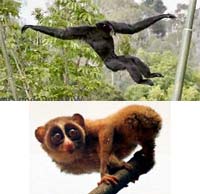
![]() Studying the way an animal moves by looking at its ears might seem like a poorly thought-out strategy. After all, short of watching it directly, most biologists would choose to look at more obvious traits like tracks, or limb bones.
Studying the way an animal moves by looking at its ears might seem like a poorly thought-out strategy. After all, short of watching it directly, most biologists would choose to look at more obvious traits like tracks, or limb bones.
 But while an animal's limbs may drive it forward, its inner ear makes sure that it doesn't immediately fall over. By controlling balance, it plays a key role in movement, and its relative size can tell us about how agile an animal is.
But while an animal's limbs may drive it forward, its inner ear makes sure that it doesn't immediately fall over. By controlling balance, it plays a key role in movement, and its relative size can tell us about how agile an animal is.
When we walk, the image that forms on our retinas changes quite considerably. But no matter how fast or erratically we move, our view of the world neither jerks nor judders. It's all stable images and smooth transitions, and the inner ear plays a large role in that.
In the inner ear, three semicircular canals control our balance by acting like small gyroscopes. The canals are bony, fluid-filled tubes arranged at right angles to each other and send information to the brain about the body's orientation.
When the body moves, so does the fluid and this sloshing is sensed by hairs in the canals and relayed to the brain. The muscles of the neck and eye tense reflexively in response to these signals, and these help to stabilise our view of the world.
In humans, the inner ear doesn't really have to work too hard - we're limited to moving on the ground, and not very quickly at that. It's a whole different story for a fast and agile animal like a bat, twisting and turning in three-dimensional airspace while avoiding obstacles and predators.
Fred Spoor from University College London and colleagues from around the world reasoned that these different movement styles must be reflected in the size of a species' balance organs. There is some evidence for this already - the practically immobile sloths have small semicircular canals, while manoeuvrable birds have relatively large ones.
But these findings seem almost anecdotal compared to the massive amount of data that Spoor collected. His group looked at the canals of 91 different species of primates, representing all the major families.
 The primates are an ideal group for this type of analysis - despite being closely related, they have a vast range of different movement styles.
The primates are an ideal group for this type of analysis - despite being closely related, they have a vast range of different movement styles.
Acrobatic gibbons swing through jungle canopies at high speed using ball-and-socket-jointed wrists (top). At the other end of the spectrum, the appropriately named slow loris is a ponderous and stealthy climber (bottom).
The group used a special CT scanner, a hundred times more sensitive than those used by hospitals, to build detailed 3-D reconstructions of the skull of each species, and the three canals inside. As well as the primates, they also looked at 119 other mammals, from mouse to elephant, and gave each one a score from one to six, based on how swift or agile they were.
As predicted, they found that the canals of agile animals with fast, jerky movements like tarsiers (image below, left) are larger for their body size and more strongly curved. Slower species like lorises have relatively small and less curved canals.
Spoor's data suggests that the size of the semicircular canals are an important adaptation to give fast-moving animals greater stability.
It explains why some primates can gracefully race through dense treetops at speeds where humans, with out relatively smaller canals, would embarrassingly collide with a branch. Just look at the video below I shot of brachiating gibbons.
This method can also be used forensically, to recreate the movement styles of extinct mammals. To prove this principle, Spoor looked at the canals of several species of extinct lemur, and found that their canals gave important clues about their behaviour.
Of the species he looked at, Palaeopropithecus had by far the smallest canals for its size. Accordingly, palaeontologists believed it was the lemur equivalent of a sloth; its hands and feet are curved for hanging from branches, and its wrists and ankles have lost the flexibility needed for effective walking.
Reference: Spoor, Garland, Krovitz, Ryan, Silcox & Walker. 2007. The primate semicircular canal system and locomotion. PNAS doi/10.1073/pnas.0704250104

One effect I noticed a long time ago is to look at a digital clock while eating something crunchy. The lines of the clock numbers jump around, but nothing else seems to be jumping around. I had assumed it was somehow the vibrations directly causing the interference, but maybe it is the brain thinking it is being jostled more than it is and overcompensating.
I think the clock numbers jump around because the LEDs are pulsing, so it's like looking at a really fast strobe light. I guess the eye movements from eating something crunchy are quick enough to make it visible, but scanning by slowly with your eyes isn't. If you look past the clock really quick you can see a trail of a few images.
Is this really a new discovery? Wasn't there an attempt, back in the 1990s, to figure out the size of a T-Rex's semi-circular canal in order to determine how well it could balance, and therefor, what its chances of being able to do a lot of running at speed without falling were?
Nice article, but where is the link to the peer-reviewed publication on which its based. Please post so we can look it up.